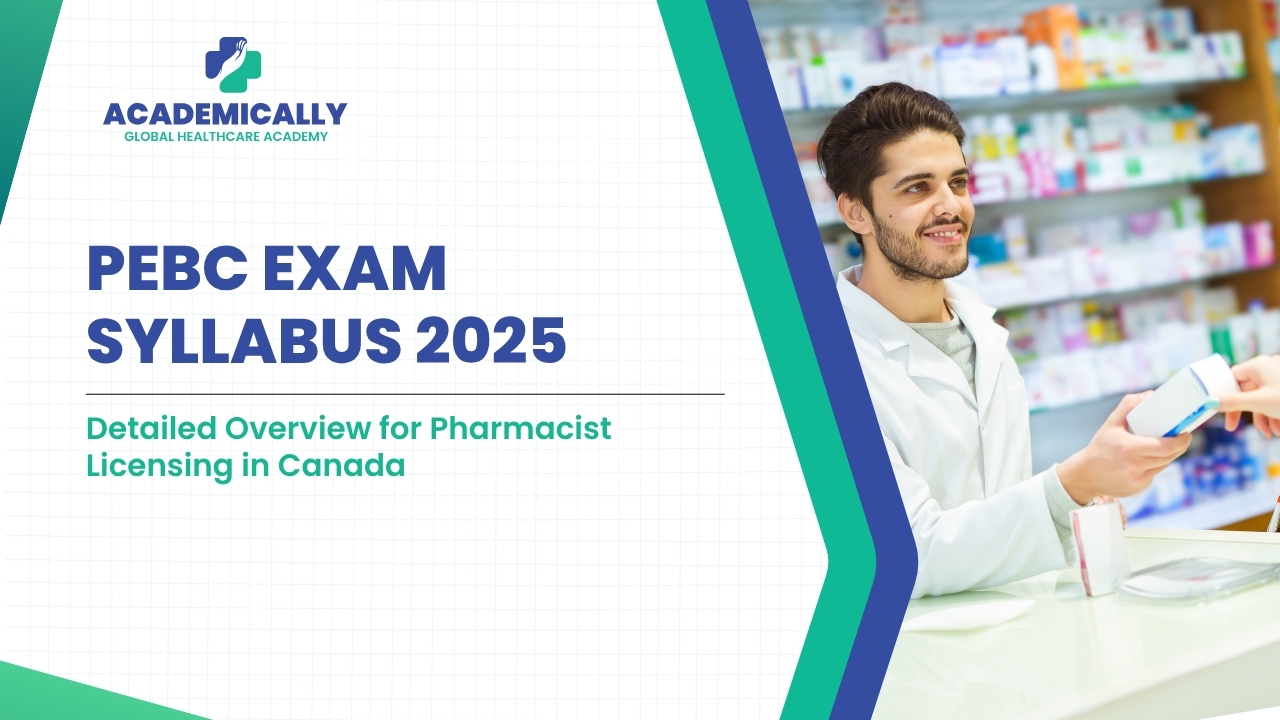So far, you are taking your first step towards becoming a licensed pharmacist in Canada, and this means that you are probably coming face-to-face with the 2025 PEBC exam course. Yes, it looks a lot, but here is the truth: When you break it with a proper strategy, it minimizes the challenges and brings it one step over the stone.
What Is the PEBC Exam?
The Pharmacy Examination Board of Canada (PEBC) is the National Certification Body that tests all pharmacists, whether trained onshore or offshore, to ensure that they are absolutely ready to practice safely and effectively in Canada. Passing the PEBC exam is not just about earning a pharmacist's title, it is proof that you are medically efficient and will also follow Canadian cultural expectations in the diverse healthcare scenario of Canada.
The licensure exam has two main parts:
- Evaluating Exam (for international graduates) – This assesses alignment with Canadian education standards
- Qualifying Exam – Consists of Part I (MCQ) and Part II (OSCE)
PEBC Exam Syllabus 2025
Blueprint & Core Domains
Based on the June 2025 blueprint, the Evaluating Exam has been reshaped:
- Pharmaceutical Sciences: 25% (Drug Mechanism, Pharmaceutics, kinetics)
- Pharmacy Practice: 55% (Clinical Medical Science, Calculation, Compounding)
- Behavior, Social, and Administrative Sciences: 20% (Ethics, Public Health, Social Determinants)
Biomedical sciences are no longer standalone—they remain integrated within other areas.
Evaluating Exam Syllabus: What to Study?
This is the first hurdle for internationally trained pharmacists. The key knowledge domains include:
- Pharmaceutical Sciences: pharmacodynamics, pharmaceutics, biopharmaceutics
- Pharmacy Practice Foundations: drug distribution, safety protocols
- Behavioral & Social Sciences: ethics, cultural competence, healthcare systems
Official syllabus PDFs are available on our Academically website — detailed topic lists outlining content and scoring weightage.
Note: In India, JSS College of Pharmacy is the only ACPE-accredited college. No evaluation exam will be needed for JSS-candidates.
Qualifying Exam Syllabus: Part I & II
Part I (MCQ)
A full-day computer-based assessment that tests your ability to apply knowledge to realistic situations, covering:
- Therapeutic decision-making
- Dosage and compounding calculation
- Drug interactions and side effects
- Case-based pharmacy practice problem-solving
You’ll want to use a dependable exam blueprint, draft study questions, and timed mock exams. Check our course page.
Part II (OSCE)
This is a skills-based practical exam, held on a different day, with stations that simulate real-world scenarios:
- Patient counseling and communication
- Medication chart interpretation
- Diagnosing and resolving drug therapy issues
- Interprofessional collaboration
OSCE preparation includes AI-based mock drills, live+recorded sessions from experts, downloadable PDF notes, community groups on WhatsApp/Telegram for support and 1-on-1 doubt-clearing sessions (tools offered by Academically.)
Also Read: PEBC Exam Cost in 2025
What's Changed in 2025?
Here are the key shifts candidates must know
- Biomedical sciences removed as a standalone, to better mirror Canadian PharmD programs
- Redistribution of focus, Clinical practice (55%), sciences (25%), admin/social (20%)
- Added emphasis on equity and cultural competence, including Indigenous and public health
- Total MCQs reduced: from 150 to 140, structured into two 90-minute sessions of 70 questions each
- No evaluating exam: if you have graduated from a program accredited by ACPE (U.S.) or CCAPP (Canada)
Build a Topic Schedule
Map out your 1200‑hour prep around the blueprint. Number your weeks by topic importance:
- Weeks 1–4: Pharm Sciences + Calculations
- Weeks 5–8: Clinical Therapeutics + Case Studies
- Weeks 9–12: Public Health / Ethics / Cultural Safety
Active Learning Works
- Rewrite notes, teach peers
- Solve 2–3 sentinel cases per week
- Create flashcards (Systems + Definitions = recall gold)
Mock Exams: A Must for the PEBC exam
- Do timed MCQ batches weekly
- Specifically prepare OSCEs through role-play or recorded sessions
Focus on Canadian Practice
- Examine NAPRA Model Standards of Practice
- Get familiar with provincial drug regulations
- Focus on ethical dilemmas and interprofessional collaboration
Self‑Care = Smarter Prep
- Eat well, stay active, sleep 7–8 hrs
- Take structured breaks
- Practice stress-management techniques before mock tests
Special Advice for International Graduates
If you trained outside Canada:
- Master the structure of Canadian healthcare and the pharmacist’s role
- Study local legislation, ethics, and privacy laws
- Practice communication skills across diverse patient populations
Many candidates benefit from “bridging” programs (e.g. UBC, U of Toronto, U Alberta) tailored for international grads.
Summary of 2025 PEBC Syllabus Breakdown
| Exam Stage | Sections | Main Topics |
| Evaluating | MCQs | Pharm Sciences, Practice Foundations, Admin/Social Ethics |
| Qualifying Part I | MCQs | Therapeutics, Calculations, Drug Safety, Clinical Reasoning |
| Qualifying Part II | OSCE | Counseling, Chart Review, Patient Safety, Interprofessional Skills |
Final Thoughts: Your Path to PEBC Success
The 2025 PEBC exam syllabus is deliberately structured to ensure every future pharmacist is capable of evidence-based, compassionate, and culturally safe healthcare. Here's a final roadmap:
- Download the 2025 syllabus PDF – commit to it
- Plan a weekly study agenda aligned with percentage weights
- Join a course, Learn from the PEBC qualified mentors
- Take regular mock MCQs and fully timed OSCE drills
- Tap the right study materials: textbook + online Q‑banks + OSCE prep courses
- Learn about Canadian regulations and cultural contexts
- Look after your mind and body—wellbeing is performance
This journey is a marathon, not a sprint. With the right plan—and a bit of perseverance—you’re setting yourself up to become a confident, competent pharmacist in Canada. Your future patient is waiting—let’s complete this journey together.




